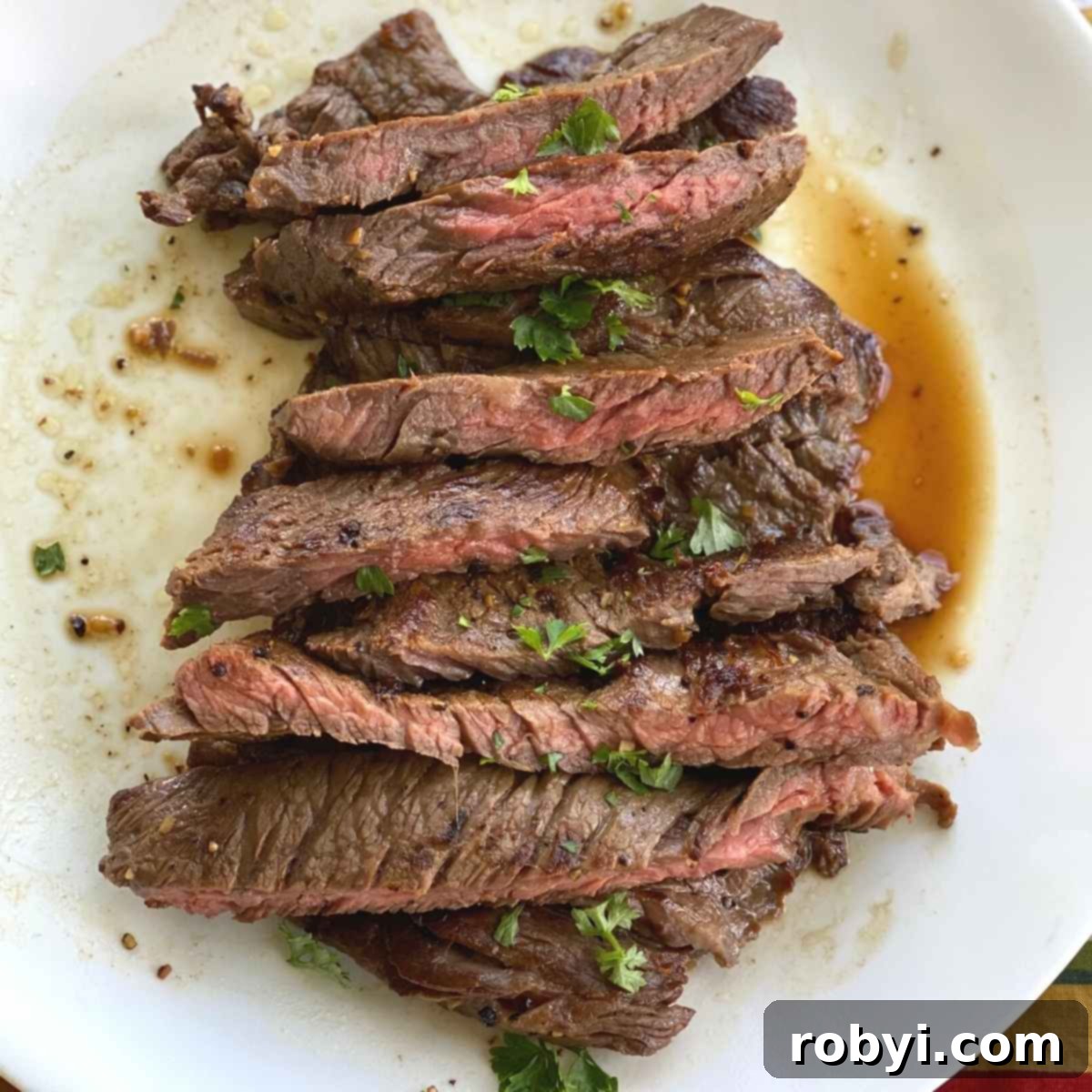Discover the secrets to cooking a perfect, tender, and incredibly flavorful **Bavette Steak** right on your stovetop. This easy-to-follow guide will show you how to achieve restaurant-quality results in mere minutes, transforming a humble cut into an unforgettable meal.
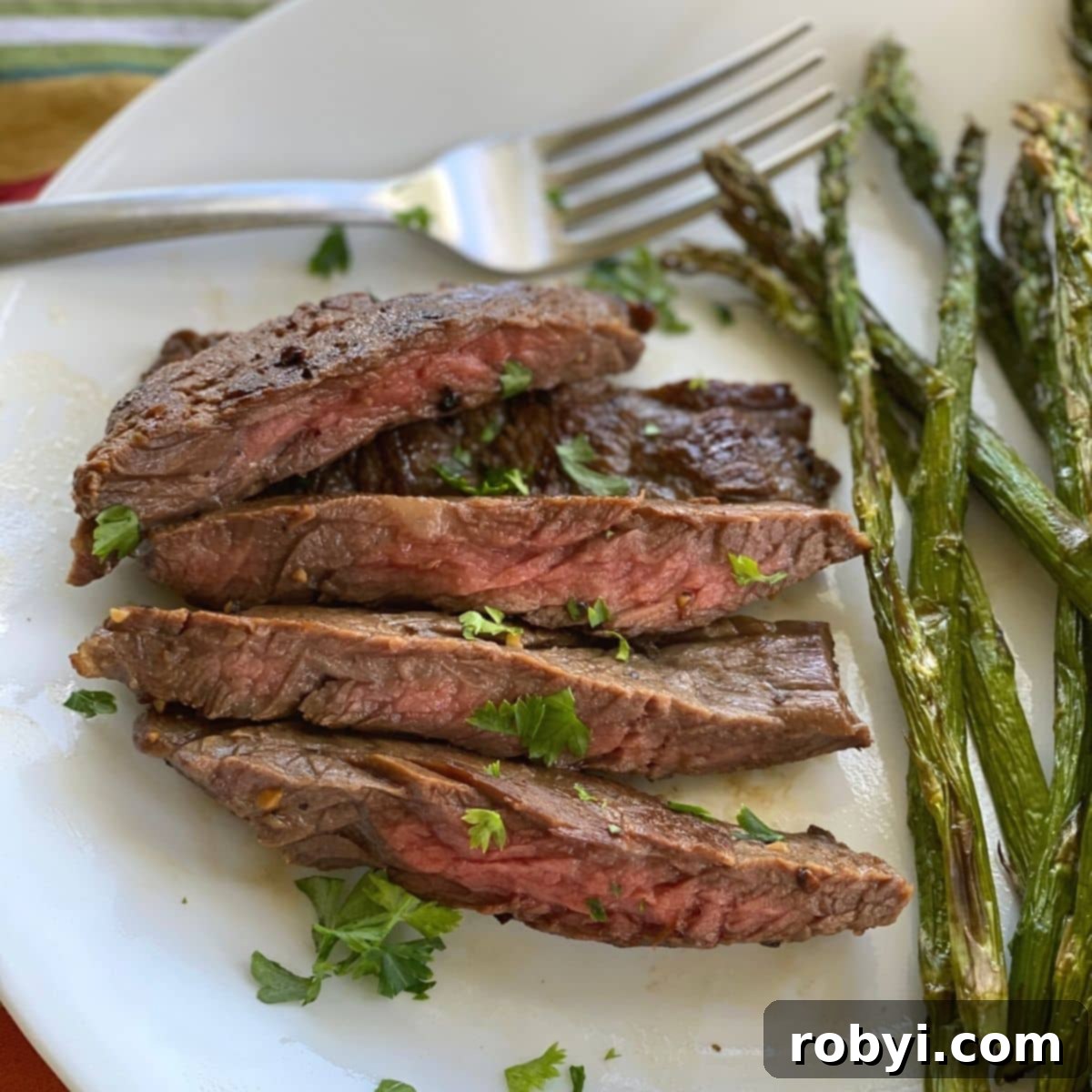
While often overlooked, bavette steak, also known as flap steak, is a hidden gem in the world of beef cuts. With its rich, beefy flavor and inherently tender texture when cooked correctly, it promises an impressive dining experience without the fuss. This versatile cut is perfect for a quick weeknight dinner or a special occasion when you want to impress.
Many home cooks might mistake bavette for flank steak, and while they share some similarities and can often be used interchangeably in recipes, understanding their subtle differences can elevate your cooking. The techniques shared here for pan-searing bavette will also yield excellent results for flank steak, making this a truly adaptable method.
Beyond being pan-seared to perfection, bavette steak lends itself beautifully to various dishes, from vibrant air-fried steak fajitas to savory sesame beef stir-fries. However, we believe its robust flavor truly shines when it’s simply prepared and served alongside your favorite seasonal vegetables, perhaps with a drizzle of a creamy sauce like an easy blue cheese sauce. This approach makes it a fantastic option for a quick and easy meal that doesn’t compromise on taste or quality.
This comprehensive guide will walk you through everything you need to know, from selecting the right cut to mastering the pan-searing technique, ensuring every bite of your bavette steak is tender, juicy, and packed with flavor.
What is Bavette Steak? A Butcher’s Secret Revealed
“Bavette” is a French term meaning “bib” or “flank,” aptly describing this cut’s distinctive fan shape. For those looking to impress, you might use its full French name, “bavette d’aloyau,” which translates to “sirloin bib” or “sirloin bavette.” More commonly in English-speaking regions, it’s known as flap steak or flap meat – names that, unfortunately, don’t quite capture its culinary appeal!
Prized by chefs and steak enthusiasts alike, bavette steak is celebrated for its incredibly rich, beefy flavor and a tenderness that rivals more expensive cuts when prepared correctly. What makes it so special? A closer look reveals fine marbling throughout and a loose, open grain texture. This unique structure is a true advantage for home cooks, as it allows marinades and seasonings to penetrate deeply and quickly, infusing the meat with flavor and contributing to its exceptional juiciness.
Despite its rich attributes, bavette steak is often confused with flank steak due to its anatomical proximity, as both come from the underbelly area of the steer. However, bavette originates specifically from the sirloin primal, while flank steak comes from the flank primal. This distinction is important because the muscle fibers and fat distribution differ, affecting how each cut responds to cooking. Bavette typically has a slightly looser grain and more marbling than flank, contributing to its generally more tender nature when sliced against the grain.
Sourcing Your Bavette Steak: Tips for the Savvy Shopper
While gaining popularity, bavette steak may not be a staple in every local grocery store’s meat case. You might need to make a special request from your local butcher. Don’t be shy! A knowledgeable butcher can often cut a thicker steak in half for you, which is ideal for achieving that perfect, quick pan-sear on the stovetop. When selecting your bavette, look for a vibrant red color, good marbling (small flecks of fat distributed throughout the muscle), and a firm texture. If you can’t find bavette, remember that flank steak is a suitable substitute, though you might need to adjust cooking times slightly due to potential differences in thickness and fiber structure.
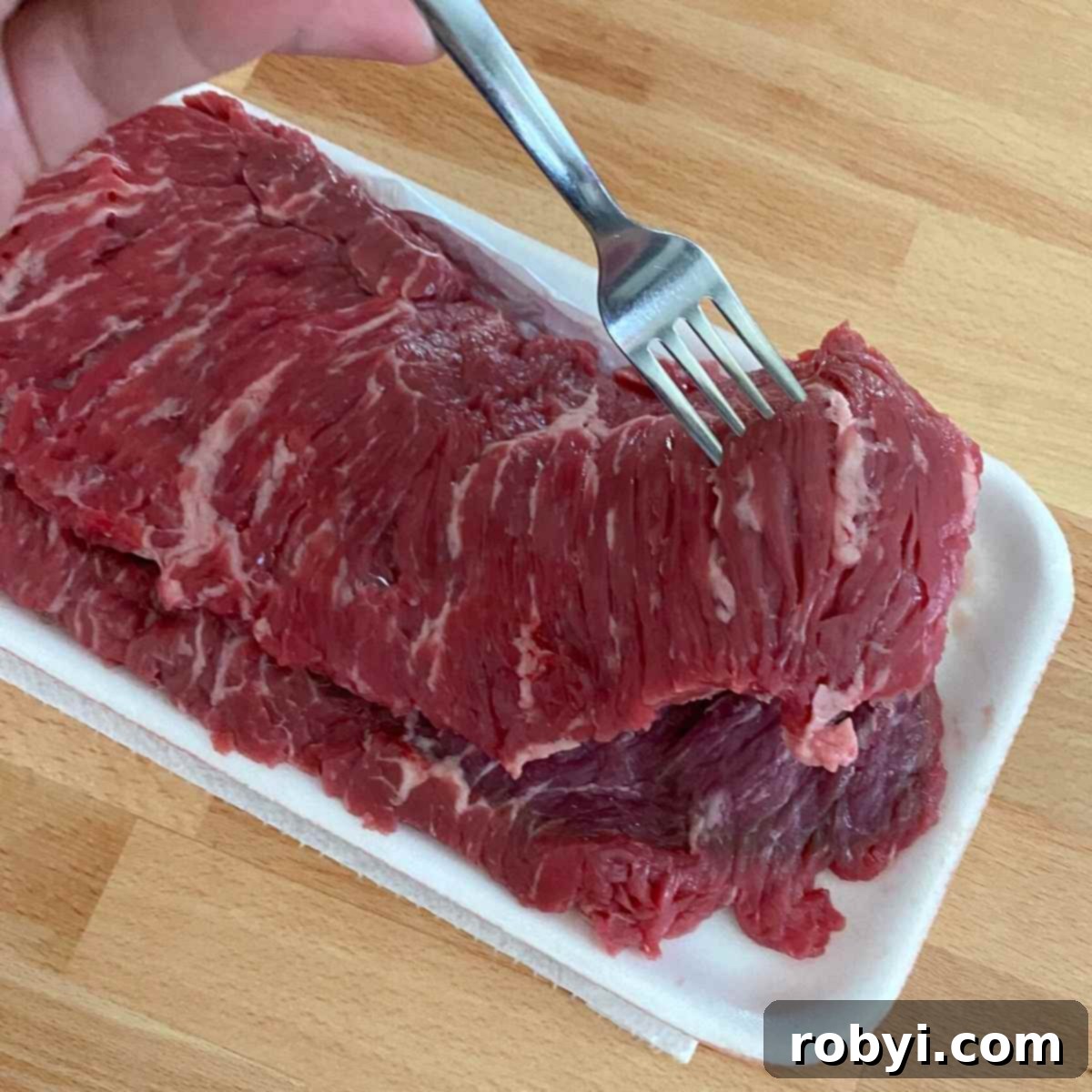
Marinade vs. Rub: Maximizing Flavor for Your Steak
One of the beauties of bavette steak is its ability to absorb flavors quickly and efficiently, thanks to its loose, open grain. This makes it an ideal candidate for both marinating and simple seasoning with a dry rub. Both methods can lead to a delicious steak, but they achieve their goals in slightly different ways.
The Power of a Quick Marinade
Marinating involves soaking the meat in a seasoned liquid, which not only tenderizes the fibers but also infuses the steak with deep, complex flavors. For bavette, you don’t need a long marination time; even 30 minutes can make a significant difference due to its permeable texture. This quick marinade recipe is perfect for up to 2 pounds of bavette or flap steak:
- ½ cup olive oil: Acts as a carrier for fat-soluble flavors and helps prevent sticking.
- ¼ cup soy sauce (low sodium) or coconut aminos: Provides a savory umami base and helps tenderize the meat. Coconut aminos are an excellent soy-free and gluten-free alternative.
- 2-3 teaspoons Montreal Steak Seasoning or another favorite dry rub: A robust blend of coarse salt, black pepper, garlic, onion, and other spices that adds a classic steakhouse flavor. Adjust the amount based on the salt content of your chosen blend.
Why Marinate? The acid and enzymes (if any, though soy sauce is more about salt/umami) in a marinade break down tough muscle fibers, leading to a more tender chew. More importantly for bavette, the liquid penetrates the meat, carrying flavor deep within. This ensures that every slice, not just the surface, is bursting with taste.
The Simplicity of a Dry Rub
If you prefer a simpler approach or are short on time, a good quality dry rub or even just salt and pepper can create a fantastic crust and flavor. The key here is to apply a generous amount of seasoning, but be mindful of the high heat cooking process.
Important Note on Seasoning for High Heat: Since bavette steak is cooked at a very high temperature to achieve a perfect sear, certain spices in dry rubs, particularly those with a high sugar content or fine herbs, can burn before the meat is fully cooked. This results in a bitter, undesirable taste. To prevent this, if you’re not marinating, a light brush of olive oil and a generous sprinkle of coarse salt (like kosher salt or sea salt) just before cooking is often sufficient. You can always add more delicate spices or fresh herbs after the steak has rested.
Alternatively, infuse flavor through the marinating process, as suggested above, or consider finishing your steak with a flavorful compound butter or a drizzle of a prepared sauce after cooking.
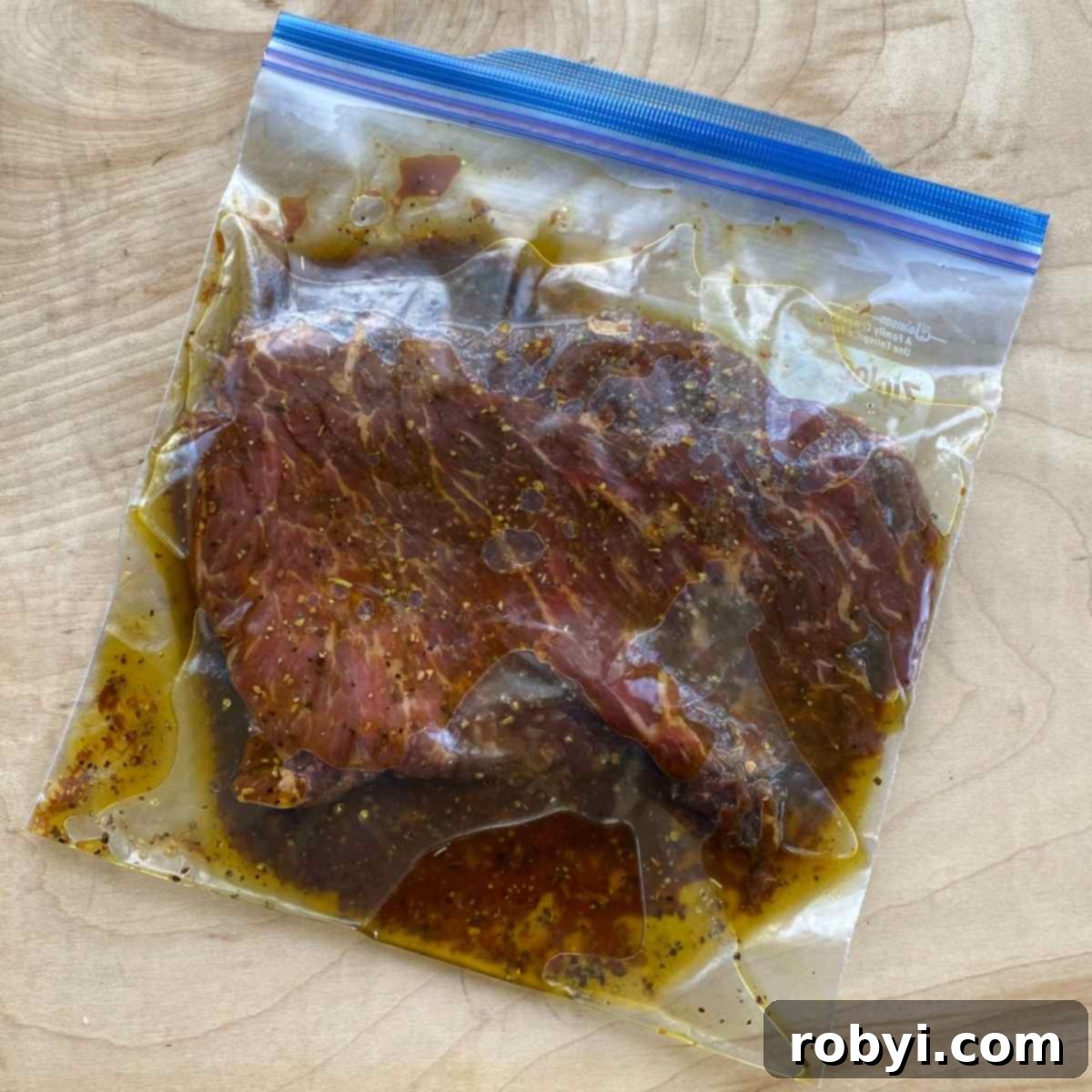
How to Pan-Sear Bavette Steak: Achieving Perfection on the Stovetop
Pan-searing is arguably the best method for cooking thinner cuts of beef like sirloin flap steak, skirt steak, and flank steak. The intense, direct heat of a hot pan creates a beautiful, caramelized crust (the Maillard reaction) while keeping the interior juicy and tender, especially when aiming for a perfect medium-rare doneness. Follow these steps for an impressive result:
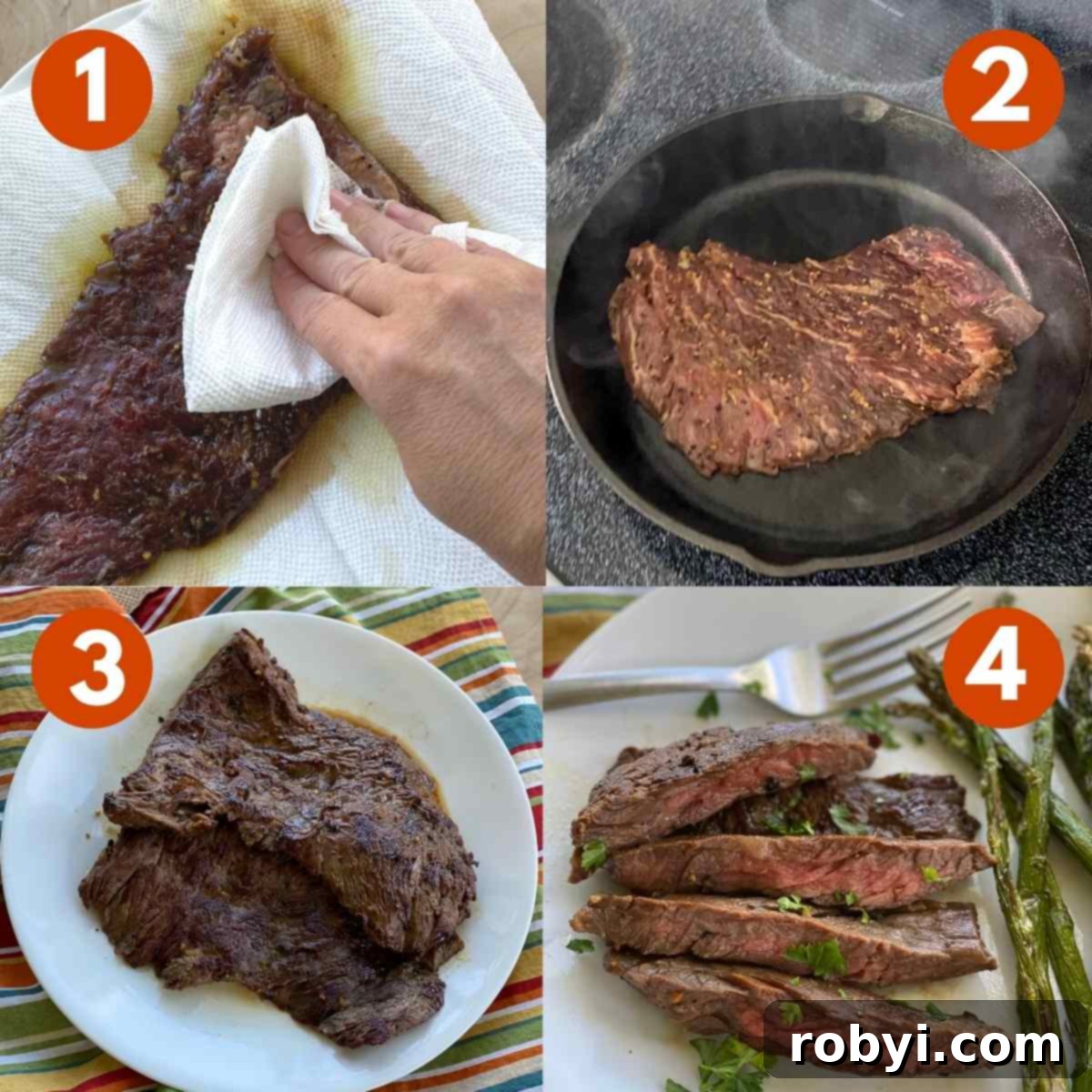
- **Prepare the Steak:** If using a marinade, remove the beef from the marinade, discard any excess liquid, and gently pat it thoroughly dry with paper towels. Brush off any visible seasoning that might burn during searing. If not marinating, simply pat the meat dry, lightly brush with olive oil, and season generously with coarse salt and freshly ground black pepper just before cooking.
- **Bring to Room Temperature:** For optimal results, allow the steak to sit out at room temperature for about 20-30 minutes before cooking. This isn’t strictly necessary, but it helps the meat cook more evenly and reduces the overall cooking time in the pan. A cold steak hitting a hot pan can cause the outer layers to overcook before the center reaches the desired doneness.
- **Heat Your Pan:** This is a crucial step! Place a cast iron skillet (or other recommended pan, see below) over high heat and allow it to preheat for a full 5-10 minutes. The pan needs to be smoking hot to achieve a proper sear. You generally don’t need to add oil or butter to the pan itself when using cast iron, as the meat will release some fat, and residual oil from marinating or brushing is usually enough.
- **Sear the Steak:** Carefully place the steak in the hot skillet in a single layer. Do not overcrowd the pan; cook in batches if necessary. Sear for 2-3 minutes per side, turning frequently (every minute or so) to build an even crust and prevent burning. The exact cook time will vary depending on the thickness of your steak and your desired level of doneness. For a steak that is approximately ½ inch thick, it might take only 4-5 minutes total, while a 1-inch thick steak could require 6-7 minutes. Use a meat thermometer to confirm internal temperature.
- **Rest the Meat:** Once your steak reaches the desired doneness (see the temperature chart below), remove it immediately from the skillet and place it on a clean cutting board or plate. Allow the steak to rest for at least 5 minutes, and preferably 10 minutes for thicker cuts. This critical step allows the juices, which have been drawn to the center during cooking, to redistribute throughout the meat, resulting in a significantly juicier and more tender steak. Cutting too soon will cause all those precious juices to run out onto the board.
- **Slice Against the Grain:** After resting, thinly slice the steak **against** the muscle fibers (the grain). This is vital for tenderness. Bavette steak has distinct long muscle fibers; slicing perpendicular to them shortens these fibers, making each bite much easier to chew and more enjoyable. Serve immediately and enjoy!
Best Type of Pan to Cook Steak for a Perfect Sear
The type of pan you use can significantly impact the quality of your pan-seared steak. The goal is to achieve a very high, consistent heat to develop a rich, flavorful crust through the Maillard reaction. Here’s a breakdown of the best options:
- **Cast Iron Skillet (Ideal):** A cast iron skillet is the undisputed champion for searing steak. Its superior heat retention and even heat distribution ensure that the entire surface of the steak makes contact with consistent high heat, leading to a beautiful, uniform crust. Once hot, it stays hot, even when cold meat is added.
- **Stainless Steel Pan or Griddle Pan (Excellent Alternative):** These are also excellent choices. Stainless steel pans can reach high temperatures and conduct heat well, though they may not retain heat as effectively as cast iron. A griddle pan, with its ribbed surface, can create attractive grill marks and allows some fat to drain, but might not produce as much overall crust as a flat-bottomed skillet.
- **Granite Pan (Good):** Granite-coated pans can perform well for searing, offering good heat distribution. They are a step up from basic non-stick pans but may not reach or maintain the extreme temperatures of cast iron or high-quality stainless steel.
- **Non-Stick Pan (Least Recommended):** While you *can* cook steak in a non-stick pan, it’s generally not the best choice for achieving that coveted, deep brown crust. Non-stick coatings are not designed for the very high temperatures required for proper searing and can degrade quickly when overheated. This means you won’t get the same level of caramelization or the intense flavor that comes from a well-seared flat cut of beef. If using a non-stick pan, avoid preheating it on high; use medium-high heat to protect the coating and accept that your crust may be lighter.
Ultimately, a heavy-bottomed pan that can withstand and retain high heat is your best friend for a perfectly seared bavette steak.
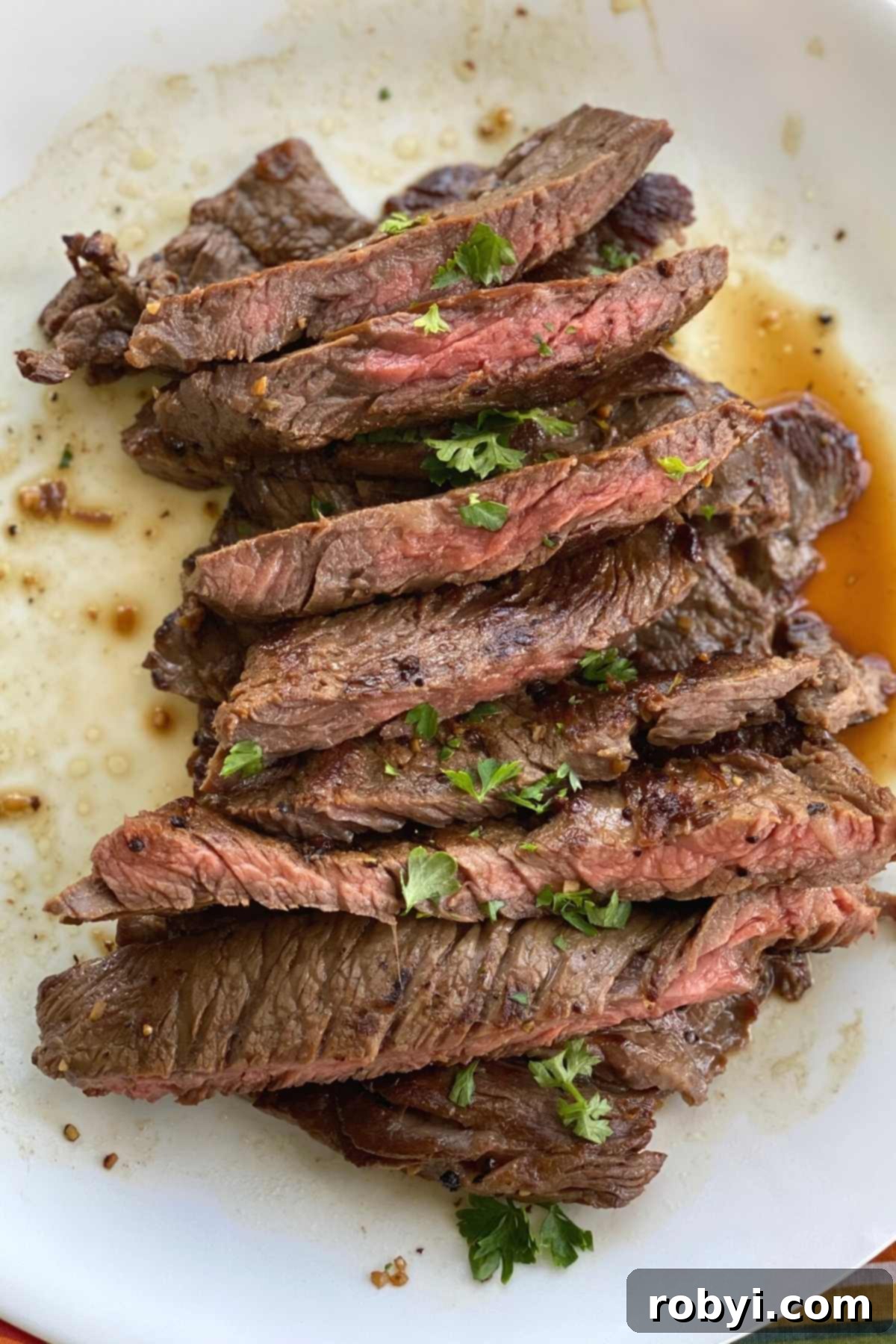
Steak Cooking Times and Doneness Guide
Achieving the perfect doneness for bavette steak, much like flank steak, is crucial for tenderness. This cut is best enjoyed cooked to medium-rare to medium. Overcooking can quickly make it tough and chewy, diminishing its otherwise delightful texture.
Always remember that meat continues to cook for a few minutes after it’s removed from the heat – a phenomenon known as “carry-over cooking.” Therefore, it’s wise to remove your steak from the pan when it’s approximately 5 degrees Fahrenheit below your target internal temperature. An instant-read meat thermometer is your most reliable tool for precision and safety.
The USDA recommends cooking beef to an internal temperature of 145°F for food safety. However, many steak lovers prefer a slightly lower temperature for optimal texture and juiciness. Here’s a general guide for various levels of doneness:
- **Rare:** 125-130 °F
- **Medium-Rare:** 130-135 °F (Highly recommended for bavette!)
- **Medium:** 135-140 °F
- **Medium-Well:** 140-150 °F
- **Well Done:** 150 °F and above (Generally not recommended for bavette due to increased toughness)
Pro Tip for Checking Temperature: Insert the thermometer into the thickest part of the steak, avoiding any bones or areas of fat, to get the most accurate reading. After cooking, allow the meat to sit for about 5-10 minutes before slicing. This resting period is non-negotiable for juicy steak, as it allows the internal juices to redistribute evenly throughout the cut, preventing them from spilling out when you slice it.
What to Serve with Bavette Steak: Complementary Pairings
Bavette steak’s robust flavor makes it a fantastic centerpiece, and it pairs beautifully with a wide array of side dishes. Whether you’re looking for something fresh, hearty, or quick, here are some easy ideas to round out your dinner:
Green & Hearty Vegetable Sides:
- Crispy Roasted Green Beans: Quick to make in an air fryer or oven, these provide a delightful crunch.
- Okra Fries: An unexpected yet delicious alternative to traditional fries.
- Garlic Parmesan Asparagus: Simply roasted or steamed asparagus with a sprinkle of garlic and cheese.
- Broccoli or Brussels Sprouts: Roasted with olive oil and a pinch of salt until tender-crisp.
Comforting Starches & Mashes:
- Loaded Cauliflower Mash: A low-carb, creamy alternative to mashed potatoes, easily made with frozen cauliflower.
- Creamy Mashed Potatoes: A classic comfort food that perfectly balances the steak’s richness.
- Roasted Sweet Potatoes: Cubed and roasted for a slightly sweet and earthy complement.
- Corn on the Cob: Microwave it in the husk for minutes for a super easy side.
Fresh Salads & Bright Flavors:
- A simple green salad with a light vinaigrette, such as a Sweet Red Wine Vinegar Dressing.
- Tomato and Mozzarella Salad: Fresh tomatoes, mozzarella, and basil drizzled with balsamic glaze.
- Chimichurri Sauce: A fresh, vibrant herb sauce that cuts through the richness of the steak beautifully.
The key is to choose sides that offer a contrasting texture or flavor profile to enhance the overall meal. Whether you go for light and fresh or rich and comforting, bavette steak is a versatile star that can handle it all.
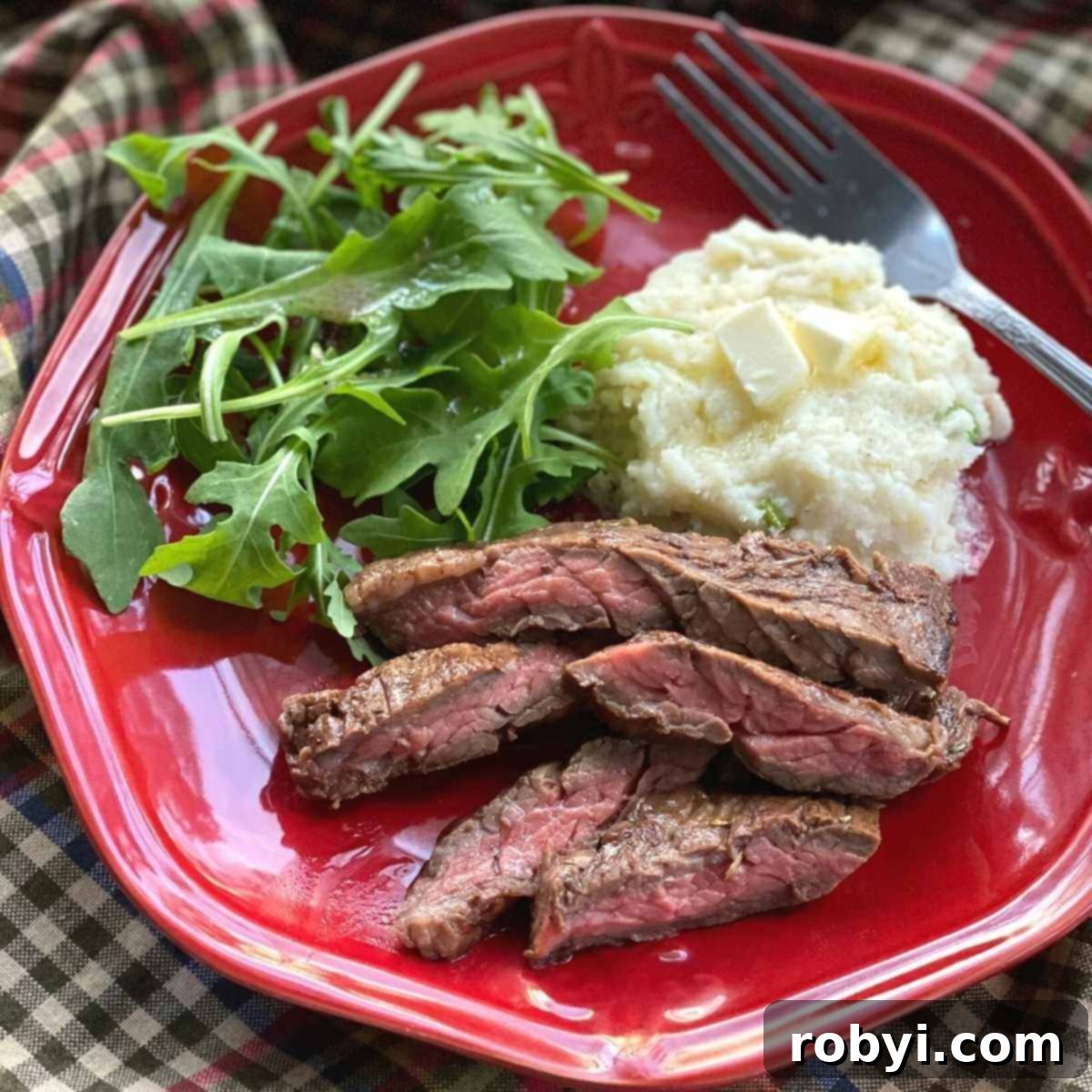
Explore More Delicious Steak Recipes
If you’ve enjoyed mastering the bavette steak, you’ll love exploring other fantastic steak recipes that are perfect for home cooking. Expand your culinary repertoire with these tender and flavorful options:
- Flank Steak Pinwheels (Oven)
- Best London Broil in the Oven
- Easy Air Fryer Steak Bites Recipe (with Mushrooms)
Would you like more easy, healthy, carb-conscious recipes?
📋 Recipe: Easy Pan-Seared Bavette Steak

Easy Bavette Steak Recipe (Pan-Sear on Stovetop)
This Bavette Steak Recipe yields tender, flavorful steak and takes minutes to pan-sear on the stovetop. An easy method with impressive results for any home cook.
Pin Recipe
Rate This Recipe
Ingredients
- 1 pound bavette steak (or flap steak) (bring to room temperature if possible; flank steak can also be used)
With Marinade (Optional)
- ½ cup olive oil
- ¼ cup low sodium soy sauce (or coconut aminos for soy-free)
- 2 teaspoons Montreal steak seasoning (or your favorite dry rub)
Without Marinade
- 1 teaspoon coarse salt
- 2 teaspoons olive oil (for brushing)
Instructions
- Remove meat from the refrigerator about 20-30 minutes before cooking to allow it to come closer to room temperature. This promotes more even and quicker cooking.
- If using marinade: In a shallow dish or sealable plastic bag, combine marinade ingredients. Add the bavette steak and marinate for about 20-30 minutes while it comes to room temperature. When ready to cook, remove the meat from the marinade, discarding any excess liquid. Pat the steak thoroughly dry with paper towels and brush off any visible seasoning particles to prevent them from burning during searing.
- If not using marinade: Pat the meat dry with paper towels, lightly brush both sides with olive oil, and season generously with salt and pepper just before cooking.
- Heat a heavy-bottomed pan, preferably a **cast iron skillet**, over high heat for about 5-10 minutes until it’s smoking hot. You typically don’t need to add additional oil or butter to the pan itself for a cast iron skillet. Carefully place the steak in the hot skillet and sear for 2-3 minutes per side, turning frequently (every 1 minute or so) until a deep brown crust forms and the internal temperature reaches your desired doneness (see notes below). Cooking times will vary based on thickness; a 1-inch thick steak will take approximately 6-7 minutes total (3-4 minutes per side).
Note for Non-Stick Pans: If using a non-stick pan, do NOT preheat on high. Heat the pan over medium-high heat for a few minutes and then add the meat. While a crust will form, it won’t caramelize to the same extent as it would in a cast iron skillet due to lower heat tolerance.
- Remove the steak from the pan and transfer it to a cutting board. Allow it to rest for at least 5-10 minutes. This crucial step allows the juices to redistribute throughout the meat, ensuring a tender and juicy result. After resting, thinly slice the steak **across the grain** and serve immediately.
Notes
You’ll find more expert tips and step-by-step pictures in the article above!
The USDA recommends that beef cook to an internal temperature of 145°F. However, here are approximate temperatures for other results, keeping in mind carry-over cooking:
- Rare: 125-130 °F
- Medium-Rare: 130-135 °F
- Medium: 135-140 °F
- Medium-Well: 140-150 °F
Always use an instant-read meat thermometer for accuracy and safety.
Nutrition
Protein: 24g |
Fat: 8g |
Saturated Fat: 3g |
Cholesterol: 68mg |
Sodium: 642mg |
Potassium: 387mg |
Calcium: 24mg |
Iron: 2mg
Nutritional and Food Safety Disclaimer
